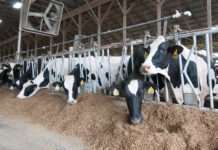For audio version, visit kansaswheat.org.
The U.S. and world wheat markets are seeing the tightest ending stocks-to-use ratios in nearly a decade — two driving factors behind higher average wheat prices. Kansas producers should keep a close eye on the factors behind these trends as they enter fall planting, according to Daniel O’Brien, K-State extension agricultural economist.
O’Brien detailed the outlook for the grain market for 2021-2022 during the 2021 Risk and Profit Conference. The 2021 Risk and Profit Conference is Kansas State University’s annual meeting to cover the latest research from the K-State Department of Agricultural Economics and hot topics for Kansas producers. This year’s in-person conference took place August 19 and 20, followed the next week by an online series of presentations the following week.
The stocks-to-use ratio helps measure the interrelationship between the supply and demand of a commodity. The ratio measures a commodity’s available stocks as a share of the commodity’s use (both domestic and exports) for a marketing year. When supply is tight compared to demand, the ratio is lower — referred to as tighter — indicating prices should rise. In contrast, ample supplies compared to demand increase the ratio, indicating prices should be lower.
For wheat, the U.S. market has the tightest ending stocks-to-use since the 2013-2014 marketing year at 30.45 percent, driven by decreased production this year. Similarly, the world wheat market ending stocks-to-use is 21.5 percent, the tightest since the 2007-2008 marketing year. Both ratios correlate with higher average wheat farm prices, but the question remains if prices will stay high throughout the 2021-2022 growing season.
O’Brien guided farmers to watch the release of the World Agricultural Supply and Demand Estimates (WASDE) report from the World Agricultural Outlook Board (WAOB). This monthly report will likely bring grain market volatility as data is gathered about further 2021 crop production declines — both decreased yields and abandoned acres — from U.S. corn, soybean and hard red spring (HRS) in the northern states. Depending on the degree of the crop decline, the details in this report could be supportive to bullish. Keep up with the report and find all reporting dates at https://www.usda.gov/oce/commodity/wasde.
O’Brien said there is support from strong new crop futures and prospects for hard red winter (HRW) planting this fall, but there is strong competition for acreage from other crops. Still, soil moisture will likely be the key factor in which crop producers plant where, especially given the emergence of a La Niña weather pattern that could cause even drier conditions.
Ultimately, O’Brien said the risk of wheat futures, along with corn and soybean futures, is less likely to fall sharply this fall due to tight beginning stocks. However, if crop prospects — both in the United States and abroad — become ok-to-good in 2022, prices will likely start to slide by late spring or early summer. Grain markets might also start to discount the risk of short crops in 2022.
In addition to discussing the grain market outlook and international markets, K-State economists at the 2021 Risk and Profit Conference also covered a wide range of production practices, income tax changes, new web tools, the outlook for cash rents, conservation practices, employee management and crop and livestock reporting. The conference also included sessions on other relevant factors affecting Kansas producers, including economic viability for rural communities, trends in nontraditional lending, carbon credit markets and post-COVID-19 impacts on the beef industry.
Missed the conference? Find the entire set of presentations online at https://agmanager.info/events/risk-and-profit-conference/previous-conference-proceedings/2021-risk-and-profit-conference.
###
Written by Julia Debes for Kansas Wheat



